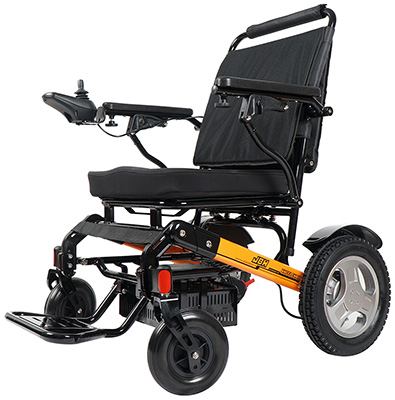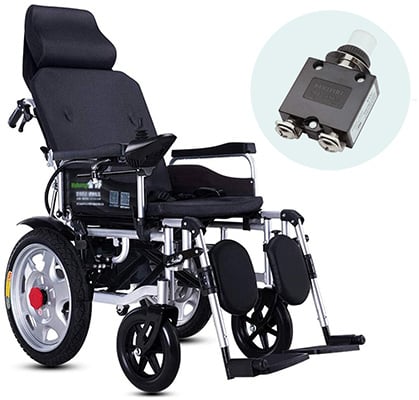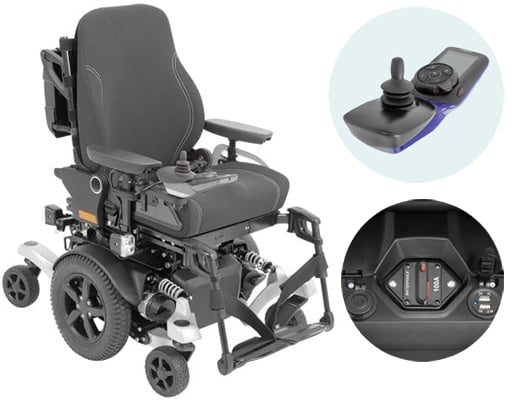You might have the fastest power wheelchair on the block, but have you ever nudged it uphill and experienced a circuit breaker trip?
Though it won’t cause your chair serious damage, it can leave you stranded in the middle of nowhere until the system cools down.
In our post, we discuss powerchair circuit breaker dynamics so you know what to do in case you have to deal with a tripped breaker.
Understanding Powerchair Electronics

Before we get into circuit breaker intricacies, it’s important to know the basics of the powerchair electrical system. There are two main parts we’ll be discussing: the controller and the circuit breaker.
Bear in mind that every powerchair model is different, so you’ll want to consult your owner’s manual to learn where your chair’s electrical components are located and how to operate them safely.
Now, it’s understandable that not everyone is a whiz at wheelchair gadgets and gizmos, so we’ll give you a visual example to explain how the controller and circuit breaker work together.
Say you have a chair that features a 50A controller and a 35A circuit breaker. The controller has a 100A peak draw when exerting max power, which splits 50A to each motor.
The circuit breaker will also experience a 100A peak, but due to its thermal capabilities, it won’t trip until it reaches and holds 35A+ for a length of time. It builds heat and can handle a full load, but at a certain point, will overheat and trip.
The most common electric wheelchair problems have to do with a malfunctioning circuit breaker. We’ll talk more about this in the next section.
An In-Depth Look at the Wheelchair Circuit Breaker

As mentioned, the reason why the circuit breaker trips is because it gets overloaded. There are many causes for tripping, including:
Now, some powerchair models are more prone to tripping than others. That’s because the chair design plays a major role in how the controller and circuit breaker interact.
For instance, a powerchair built primarily for use indoors probably wouldn’t trip with a 50A controller and a 35A circuit breaker since it’s not being used in an overly strenuous environment.
In other words, You won’t have to worry about the chair sustaining peaks of current for long periods.
However, if you were to take that low-end powerchair outdoors in rough terrain, the chair might be forced to sustain long peaks of current that cause the circuit breaker to trip. It just doesn’t have the power capabilities to handle that kind of exertion.
That’s why a more rugged powerchair design built for the outdoors typically features a 70A controller and 70A circuit breaker. This system can sustain higher peaks without overwhelming the breaker. That means a lower chance of tripping!
Pro Tip: If a breaker’s rating is the same or close to the controller’s rating, the powerchair protects the system by folding back and automatically decreasing controller power output.
Breaking Down Controller Fold-back and Circuit Breaker Protection
Controller fold-back and the circuit breaker tripping are both thermal protective measures integrated by the powerchair designer.
You might be wondering why they’re different and which type of system is better for your wheelchair.

The controller fold-back offers internal thermal protection while the circuit breaker protects the system from shorting.
Honestly, both play pivotal roles, and your best bet is to go for a design that best pertains to your needs.
In our opinion, the controller fold-back is slightly better because your wheelchair won’t shut down completely, leaving you stranded.
It simply lowers the power so that your chair is still operable- just at a snail’s pace.
Sure, your wheelchair might slow down with a fold-back mechanism, but it’s better than being stranded in the middle of the street with a tripped wheelchair circuit breaker. You can at least scoot out of the way of traffic!
A tripped circuit breaker isn’t a serious malfunction that means your wheelchair is broken. You’ll just have to wait a bit, then hit the reset button to power it up again.
All in all, a system with both enhances the performance of powerchairs and prevents inconvenient electric wheelchair troubleshooting that may occur if you only have a circuit breaker.
Final Thoughts on Powerchair Circuit Breaker Dynamics
In case of overheating, powerchairs are equipped with a controller and circuit breaker that protects the electrical system in different ways.
Though the circuit breaker trips when overloaded with power for some time, it shuts down to prevent catastrophic shorting. On the other hand, some controllers fold back, automatically reducing power for thermal protection.
When it comes to powerchair circuit breaker dynamics, the design and purpose of your chair is the biggest indicator of whether it is prone to tripping. For example, if your chair was meant for indoor use, it might not have the power capability to handle rough terrain outdoors.
Resources & References:
- Circuit Breaker, Wikipedia.
- Power Wheelchairs and User Safety, Agis.